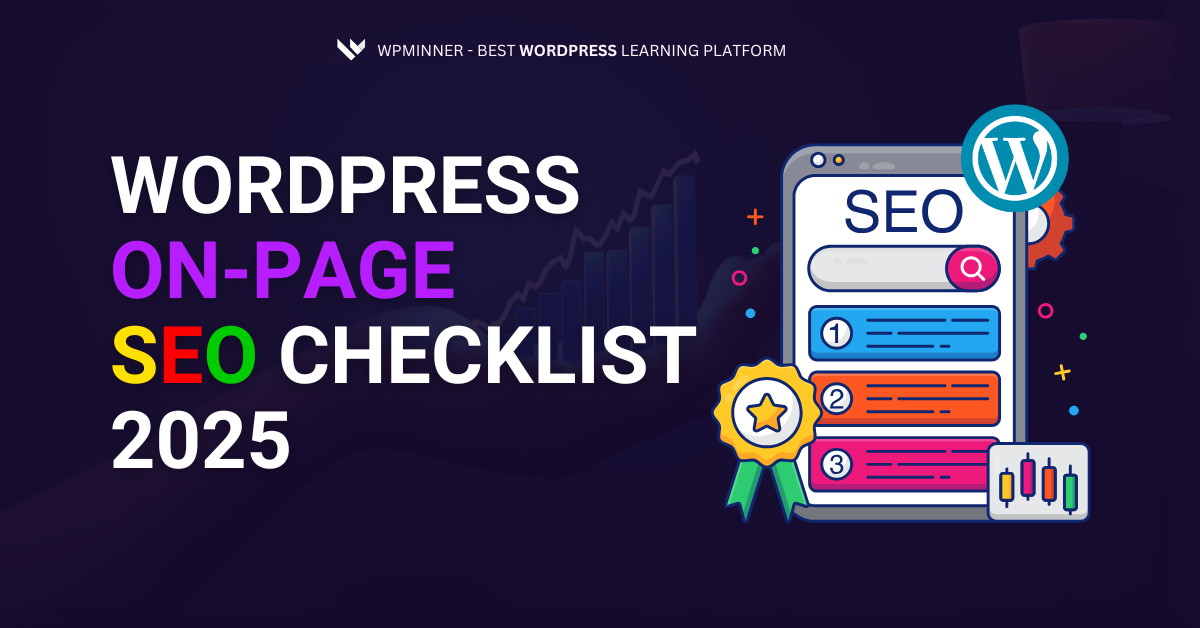Introduction: Why On-Page SEO Matters More Than Ever in 2025
If you’re running a WordPress website, you’ve probably heard that SEO is important. But what exactly does that mean? More specifically, what does a solid WordPress on-page SEO checklist look like?
Whether you’re a blogger, small business owner, or running an online store, optimizing your WordPress site’s on-page SEO can be the difference between a page that ranks on Google… and one that gets lost in the noise.
In this guide, I’ll walk you through a complete, beginner-friendly WordPress on-page SEO checklist. Not only will this help you increase organic traffic, but it will also lay the foundation for long-term growth—and even better, help you monetize your site more effectively.
🧩 What is On-Page SEO?
On-page SEO refers to all the actions you can take on your website to improve its ranking on search engines. This includes optimizing:
-
Titles and meta descriptions
-
Headers and content structure
-
URLs and internal linking
-
Image alt texts and media
-
Page speed and mobile responsiveness
For WordPress users, this becomes even more streamlined with plugins like Yoast SEO, Rank Math, or All in One SEO.
✅ Complete WordPress On-Page SEO Checklist (2025 Edition)
Let’s dive into the checklist you need to optimize your WordPress site properly.
1. Optimize Your Page Titles
Your page title (also known as the SEO title) is often the first thing users see in search results. Make it count.
-
Include your primary keyword: WordPress on-page SEO checklist
-
Keep it under 60 characters
-
Make it engaging and relevant
✅ Example:
“Ultimate WordPress On-Page SEO Checklist to Skyrocket Your Rankings in 2025”
2. Write a Compelling Meta Description
While not a direct ranking factor, a strong meta description increases click-through rates.
✅ Tips:
-
Use your keyword naturally
-
Aim for 155–160 characters
-
Highlight the benefit of reading your post
3. Use Only One H1 Tag (Your Main Title)
Make sure your blog post or page has only one H1, and it should contain the keyword “WordPress on-page SEO checklist.” All other headings should use H2, H3, etc.
4. Use SEO-Friendly URLs
Keep URLs short, relevant, and keyword-rich. Avoid unnecessary numbers or stop words.
✅ Example:https://yourdomain.com/wordpress-on-page-seo-checklist
5. Craft Valuable, Keyword-Rich Content
This is the heart of your SEO strategy. Your content should be:
-
At least 1,500 words (Google loves in-depth guides)
-
Written naturally with your target keyword used 15–20 times
-
Structured with H2s, H3s, bullet points, and numbered lists
📌 Internal Tip: Link to other relevant tools on your site like:
6. Use Internal Links Strategically
Linking to other pages on your site helps:
-
Keep users engaged
-
Spread link equity
-
Improve crawlability
✅ Pro Tip: Use descriptive anchor text like “optimize your meta descriptions” instead of just “click here.”
7. Optimize Images with Alt Text
Images enhance readability, but search engines can’t “see” them. Always:
-
Compress images for faster load times
-
Add descriptive alt tags with your target keyword when relevant
-
Use tools like TinyPNG for quick optimization
8. Ensure Mobile Responsiveness
More than 60% of users now browse on mobile. Your WordPress theme should be:
-
Mobile-friendly
-
Fast-loading
-
Easy to navigate
✅ Recommended: Use themes from Astra, GeneratePress, or Kadence.
9. Improve Site Speed
Site speed is a known Google ranking factor. To speed up your WordPress site:
-
Use caching plugins like WP Rocket
-
Optimize images
-
Minimize CSS/JavaScript
-
Choose a high-performance hosting provider (more on this below 👇)
10. Use an SEO Plugin
A powerful SEO plugin can simplify many of the tasks on this checklist.
✅ Top choices:
These plugins help you manage:
-
Titles & metas
-
XML sitemaps
-
Breadcrumbs
-
Schema markup
💡 Bonus: Schema Markup for Enhanced Visibility
Adding schema helps search engines better understand your content. This can improve visibility through rich snippets in the search results.
Most SEO plugins support this automatically—just make sure to enable it!
💻 Hosting Matters: Why Your SEO Depends on It
Many overlook hosting in their WordPress on-page SEO checklist—but it’s a big deal. A slow, unreliable host can tank your rankings, even if your on-page SEO is perfect.
That’s why I personally recommend Hostinger. It offers:
-
Blazing fast loading times
-
99.99% uptime guarantee
-
Built-in caching & optimization tools
-
Seamless WordPress installation
👉 Looking to level up your site’s SEO performance? Get started with Hostinger today! It’s affordable, beginner-friendly, and built for speed.
📌 Quick Recap: WordPress On-Page SEO Checklist
Here’s a quick summary of everything we covered:
-
Use keyword-optimized page titles
-
Write a strong meta description
-
Have only one H1 heading per page
-
Create SEO-friendly URLs
-
Write high-quality, keyword-rich content
-
Use internal and external links
-
Optimize image alt text
-
Make your site mobile-friendly
-
Improve page speed
-
Use a powerful SEO plugin
-
Add schema markup
Conclusion: Take Action on Your SEO Today
There you have it—the complete WordPress on-page SEO checklist to take your site from “meh” to “must-click” in the SERPs.
Remember, SEO isn’t a one-time task. It’s an ongoing process. But with the right tools, strategy, and hosting provider (cough Hostinger cough), you can absolutely grow your traffic, increase conversions, and maybe even earn some affiliate income while you’re at it.
🚀 Start implementing this WordPress on-page SEO checklist today—and watch your rankings rise.
🙋♂️ Frequently Asked Questions (FAQs)
🔹 What is on-page SEO in WordPress?
On-page SEO in WordPress refers to the process of optimizing individual pages or posts on your site to improve their visibility in search engines. It includes using proper headings, optimizing meta tags, images, URLs, and ensuring your content is user-friendly and keyword-rich.
🔹 How do I optimize my WordPress site for on-page SEO?
To optimize your WordPress site for on-page SEO, follow this checklist:
-
Use an SEO plugin like Rank Math or Yoast
-
Include your target keyword in titles, headings, and content
-
Add meta descriptions with keywords
-
Optimize images with alt text
-
Use internal linking
-
Create SEO-friendly URLs
-
Improve site speed and mobile responsiveness
🔹 Is Yoast SEO enough for on-page optimization?
Yoast SEO is a great tool for handling basic and advanced on-page SEO tasks, such as meta tags, XML sitemaps, breadcrumbs, and content analysis. However, combining it with quality content, fast hosting (like Hostinger), and manual optimization strategies will give you the best results.
🔹 How do I check if my WordPress SEO is working?
You can check your WordPress SEO using tools like:
-
Google Search Console (to track performance and indexing)
-
Google Analytics (to measure traffic and behavior)
-
Ahrefs or SEMRush (for keyword tracking and site audits)
-
Your SEO plugin dashboard (for technical checks)
Regularly monitor keyword rankings, traffic growth, and on-page SEO performance to ensure your efforts are paying off.
🔹 What is the best SEO plugin for WordPress?
There are several excellent SEO plugins available for WordPress. The most popular include:
-
Rank Math – Feature-rich and beginner-friendly
-
Yoast SEO – Great for content analysis and readability
-
All in One SEO Pack – Lightweight and customizable
Each plugin has its own strengths, but all support most of the essentials in this WordPress on-page SEO checklist.






